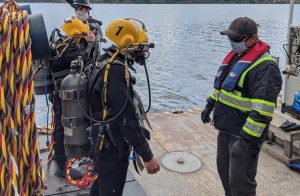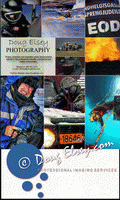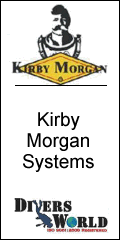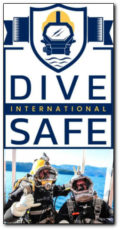Staying Healthy: Cleaning & Sanitizing Dive Equipment
By CADC Admin ~ July 20th, 2020. Filed under: Safety.
 The health of our divers and support personnel has never been more important than it is now, during the COVID-19 pandemic. We know that “hot-swapping” of diving equipment is a common, and often necessary, practice used on a dive site. We also know that, unless appropriate proactive measures are taken, we run a real risk of compromising the health of our team members and jeopardizing the completion of the job.
The health of our divers and support personnel has never been more important than it is now, during the COVID-19 pandemic. We know that “hot-swapping” of diving equipment is a common, and often necessary, practice used on a dive site. We also know that, unless appropriate proactive measures are taken, we run a real risk of compromising the health of our team members and jeopardizing the completion of the job.
Here are some practical guidelines and instructions for ensuring risks to health are not only reduced but also eliminated. This information has been collated from various equipment manufacturers and applies to all underwater breathing apparatus. First, a couple of common questions and answers.
Q: What do we mean by “cleaning” and “sanitization”?
A: “Cleaning” cares for dive equipment and helps to keep the equipment serviceable. Cleaning is the pre-cursor or foundation to “sanitization” that protects the health of our team members. Clean first, then sanitize!
Q: What is the difference between “sanitization” and “disinfection”?
A: Technically-speaking, “sanitization” reduces contamination to a safe level, while “disinfection” kills everything on a particular surface. In diving, we use the term “sanitization” to describe a less harsh process of disinfection, since we are also concerned about any process that could damage or degrade the dive equipment itself.
The COVID-19 threat
According to the Government of Canada COVID-19 website, current evidence suggests person-to-person spread is efficient when there is close contact. Viruses like COVID-19 are commonly spread from an infected person through:
- Respiratory droplets generated when you cough or sneeze;
- Close, prolonged personal contact such as touching or shaking hands; and / or
- Touching something with the virus on it, and then touching your mouth, nose, or eyes.
The best option is personal dive equipment
The best option is to have your own equipment, whether it’s a helmet or full facemask (FFM), that is only used by you. If this is not possible—for example, when using employer-provided equipment—then, having specific personal items such as your own helmet liner, oral-nasal and nose blocker is common sense and promotes good hygiene. Always remember to clean and sanitize these personal items periodically to protect yourself against other health hazards.
Three-step procedure for cleaning dive equipment in the field
- Clean external surfaces with warm, soapy water and scrub with a soft, nylon-bristle brush, if needed.
- Soapy water is defined as “household” grade liquid dishwashing detergent diluted in warm water.
- Dishwashing detergent (i.e., soap) helps break down viruses like COVID-19, which protect themselves with an oily, lipid
- Rinse thoroughly with fresh water.
- Leave to air dry naturally (smaller items can be blown dry using diving grade LP compressed air).
Sanitization procedure
Always check that your chosen sanitizing agent is effective against the particular threat—in this case, COVID-19.
Q: Is mouthwash suitable for use as a sanitizing agent?
A: No. The product may be effective against germs (primarily, bacteria) that cause plaque, gingivitis, and bad breath, but, in general, anti-bacterial and chlorhexidine mouthwashes or sprays are ineffective as sanitizing agents for dive equipment.
Q: What sanitizing agent should I use?
A: For diving purposes, the sanitizing product needs to be a broad-spectrum agent that is effective against the threats of fungus, tuberculosis, bacteria and viruses. It must also be compatible with dive equipment and be easy to use.
The foundational study and reference on this subject is the Defence Research & Development Canada (DRDC) report, A Literature Review of Disinfectants: Effects When Used by CF Divers in Cleaning Rebreather Sets.1 The information contained in this public-access document (simply Google it) is still valid today and the outcome was the adoption of Virkon S (or Virkon) for sanitization of dive equipment by the Canadian Armed Forces. There is extensive experience in Canada with Virkon, and the product is now the standard for use on all dive equipment with many other organizations and companies across Canada. Kirby Morgan has also published an online technical bulletin with advice on cleaning and sanitizing KM helmets, bandmasks, and FFM (Bulletin #3 of 2020).
There are numerous other sanitizing agents available, some of which are endorsed by manufacturers for use with breathing apparatus. For instance, Health Canada publishes an online list of hard-surface disinfectants that are “likely to be effective for use against COVID-19” (https://www.canada.ca/en/healthcanada/services/drugs-health-products/disinfectants/covid-19.html). However, beware: not all are suitable for use with underwater breathing apparatus. Due diligence is required, since the responsibility for using any sanitizing agent or disinfectant lies with the user / employer. It’s strongly recommended performance is monitored, including any potential adverse effects on equipment.
Correct dilution and adherence to contact (dwell) times are essential: always follow the instructions on the label! For example, Virkon uses a one per cent dilution strength and a recommended contact time of 10 minutes, followed by thorough fresh-water rinsing. Practical experience has proven that, with proper planning and drills, this can be achieved easily between dives and at the beginning and end of the diving day.
Maintaining the health of our dive team members is important to everyone—proper cleaning and sanitization will help. Stay clean, stay sanitized, stay healthy!
Jonathan Chapple is a former UK Royal Navy clearance diving officer and the vice-president of Aqua-Lung Canada Ltd. He is a qualified technical instructor for all major brands of Diving Life Support Equipment. He was the leader of the CSA Z275.2 working group on contaminated water diving.
Reprint from Spring Summer CADC Magazine 2020






